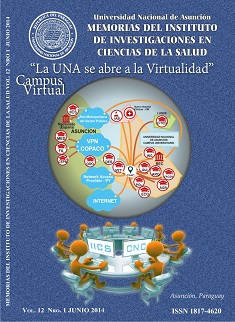Una propuesta rápida y económica para detectar el virus de papiloma humano por PCR a partir de muestras cervicales con reactivo desnaturalizante
Palabras clave:
detección de HPV, muestra cervical, reactive desnaturalizante, captura híbrida II, PCR.Resumen
Trabajos han demostrado la utilidad de la captura híbrida II (CH IIâ) en la detección del virus de papiloma humano de alto riesgo oncogénico (HR-HPV) como método de tamizaje primario para detección de cáncer de cuello uterino, así como las bondades de la PCR que permite acceder a métodos de tipificación viral. Por ello el objetivo fue detectar el genoma del HPV por PCR a partir de muestras de CH IIâ cien veces diluidas. Estudio transversal en 141 muestras cervicales de mujeres con citología normal y anormal que concurrieron al IICS, UNA. Las muestras fueron procesadas por CH IIâ y almacenadas con reactivo desnaturalizante a -80ºC. Luego, las muestras fueron diluidas 100 veces con agua destilada y posteriormente procesadas por PCR. Se detectó HPV en 51% y 43% de las muestras analizadas por CH IIâ y PCR, respectivamente. Diecisiete de 23 muestras positivas por CH IIâ con carga viral relativa baja fueron negativas por PCR. Esto podría deberse a la degradación del material. Además, 6 muestras negativas por CH IIâ fueron positivas por PCR sugiriendo presencia de infección con tipos virales no incluidos en CH IIâ. Estos resultados sugieren que es posible realizar la detección de HPV por PCR en muestras procesadas por CH IIâ previa dilución. Esta propuesta rápida, sencilla y económica, minimiza el riesgo de perder el material genético en la extracción y permite acceder a métodos de tipificación viral que podrían contribuir con datos sobre tipos de HPV circulantes para realizar una vigilancia en la era post-vacunal.
Descargas
Referencias
The International Agency for Research on Cancer (IARC). Estimated cancer incidence, mortality and prevalence worldwide in 2012. GLOBOCAN. [Internet] 2012. Lyon: WHO, 2012. [citado oct. de 2013]. Disponible en: http://globocan.iarc.fr/Default.aspx.
Zur Hausen H. Papillomavirus infections--a major cause of human cancers. Biochim. Biophys Acta. 1996 Oct; 1288(2):55-78.
Walboomers JM, Jacobs MV, Manos MM, Bosch FX, Kummer JA, Shah KV, et al. Human papillomavirus is a necessary cause of invasive cervical cancer worldwide. J Pathol. 1999 Sep;189(1):12-19.
Almonte M, Murillo R, Sánchez GI, Jerónimo J, Salmerón J, Ferreccio C, et al. New paradigms and challenges in cervical cancer prevention and control in Latin America. Salud Pública Mex 2010, 52(6):544-59.
Sijvarger CC, González JV, Prieto A, Messmer AG, Mallimaci MC, Alonio VL, et al. Epidemiología de la infección cervical por virus Papiloma humano en Ushuaia, Argentina. Revista Argentina de Microbiología 2006;38: 19-24
Rabelo-Santos SH, Levi JE, Derchain SFM, Sarian LO, Zeferino LC, Samara Messias, et al. DNA recovery from Hybrid Capture II samples stored in specimen transport medium with denaturing reagent, for the detection of human papillomavirus by PCR. Journal of Virological Methods.2005; 126:197–201.
Hubbard, RA. Human papillomavirus testing methods. Arch. Pathol. Lab. Med. 2003;127:940–45.
Khan MJ, Castle PE, Lorincz AT, Wacholder S, Sherman M, Scott DR, et al. The elevated 10-year risk of cervical precancer and cancer in women with human papillomavirus (HPV) type 16 or 18 and the possible utility of type-specific HPV testing in clinical practice. J Natl Cancer Inst. 2005 Jul 20;97(14):1072-9.
Castle PE, Solomon D, Schiffman M, Wheeler CM. Human papillomavirus type 16 infections and 2-year absolute risk of cervical precancer in women with equivocal or mild cytologic abnormalities. J Natl Cancer Inst 2005; 97: 1066–71.
Londesborough P, Ho L, Terry G, Cuzick J, Wheeler C, Singer A. Human papillomavirus genotype as a predictor of persistence and development of high-grade lesions in women with minor cervical abnormalities. Int J Cancer. 1996 Oct 21; 69(5):364-68.
Bruni L, Díaz M, Castellsagué X, Ferrer E, Bosch FX, de Sanjosé S. Cervical human papillomavirus prevalence in 5 continents: meta-analysis of 1 million women with normal cytological findings. J Infect Dis. 2010, 202(12):1789-99.
Smith JS, Lindsay L, Hoots B, Keys J, Franceschi S, Winer R, et al. Human papillomavirus type distribution in invasive cervical cancer and high-grade cervical lesions: a meta-analysis update.Int J Cancer. 2007 Aug 1;121(3):621-32.
Campos EA, Simões JA, Rabelo-Santos SH, Sarian LO, Rocha Pitta D, Levi JE, et al. Recovery of DNA for the detection and genotyping of human papillomavirus from clinical cervical specimens stored for up to 2 years in a universal collection medium with denaturing reagent. Journal of Virological Methods 2008;147: 333–37.
LaMere BJ, Howell R, Fetterman B, Shieh J, Castle PE. Impact of 6-month frozen storage of cervical specimens in alkaline buffer conditions on human papillomavirus genotyping. Journal of Virological Methods 2008;151:298–300.
Lorincz AT, Castle PE, Sherman ME, Scott DR, Glass AG, Wacholder S. Viral load of human papillomavirus and risk of CIN 3 or cervical cancer. Lancet 2002 Jul 20;360:228-29.
Manos MM, Ting Y, Wright DK, Lewis AJ, Broker TR,Wolinsky SM. The use of polymerase chain reaction amplificationof DNA with a thermostable DNA polymerase. Cancer Cell 1989; 7: 209-214.
Saiki RK, Scharf S, Faloona F, Mullis KB, Horn GT, Erlich HA, et al. Enzymatic amplification of beta-globin genomic sequences and restriction site analysis for diagnosis of sickle cell anemia. Science 1985, 230(4732):1350–54.






















